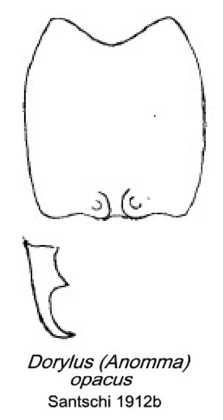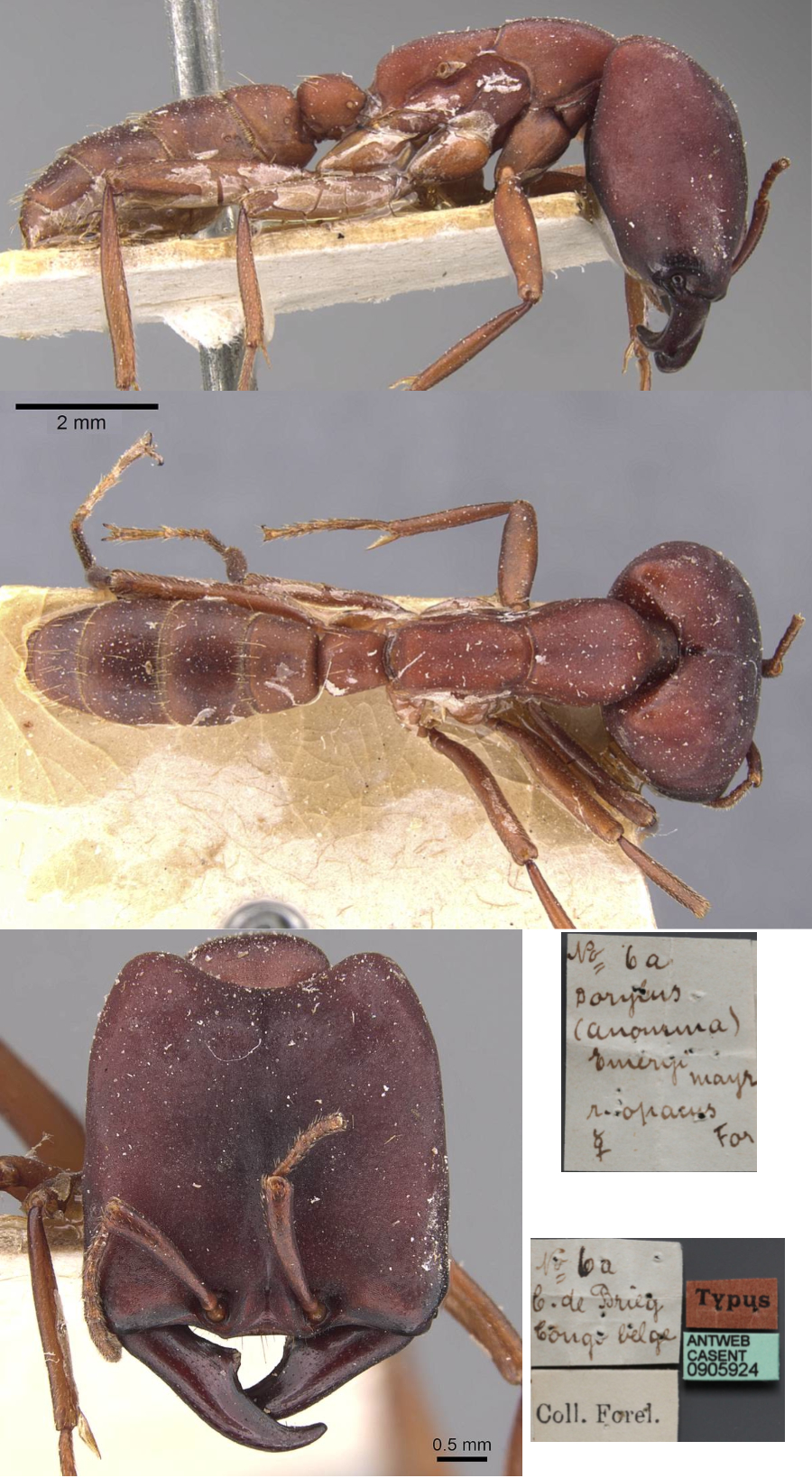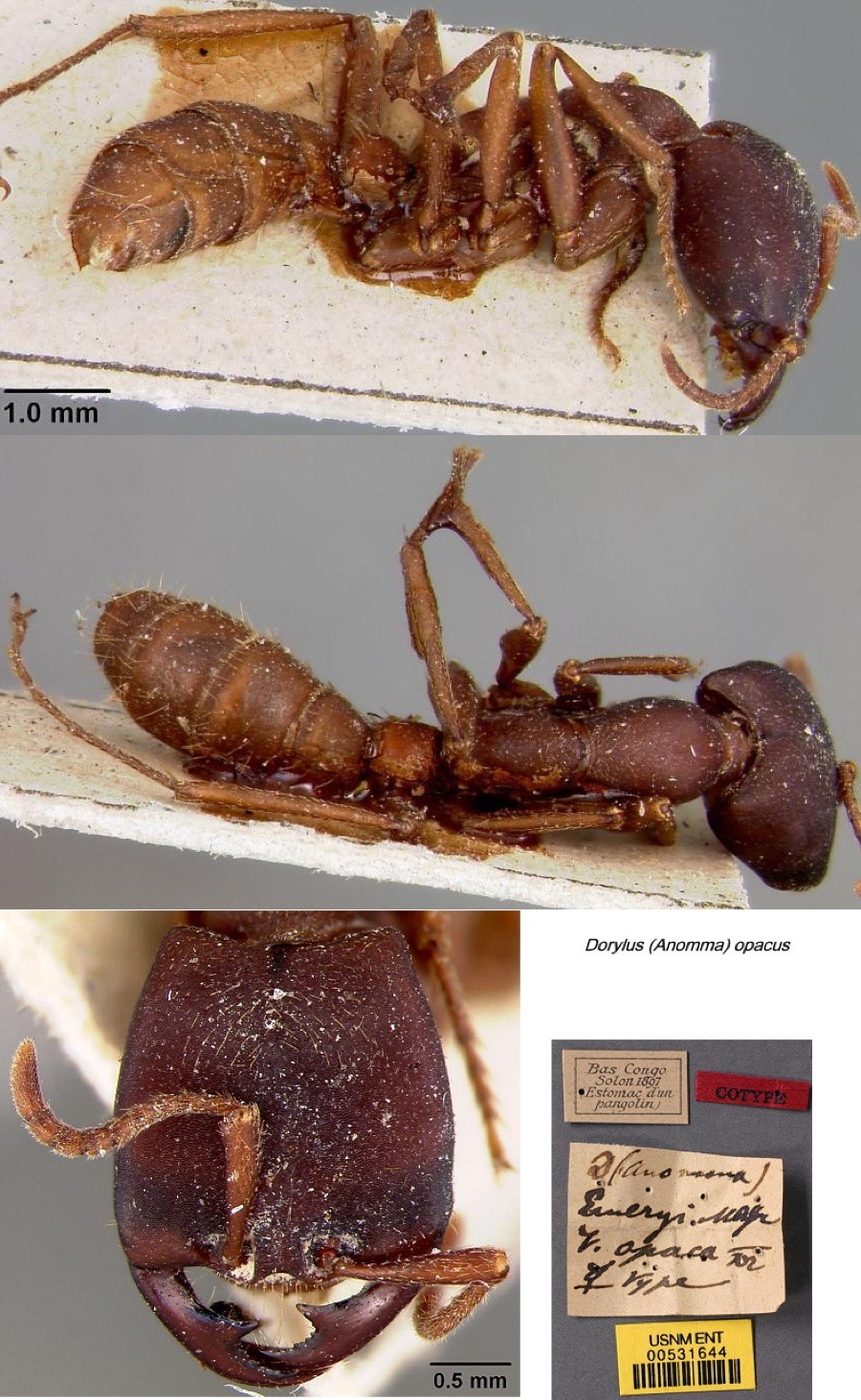Dorylus (Anomma) opacus Forel
 Male Male   Type location Zaïre (Dorylus
(Anomma) Emeryi Mayr, subsp opaca, n. subsp., Forel, 1909b:
58, workers; raised to species and illustrated by Santschi, 1912b: 154,
with male); Bas Congo, the specimens came from the stomach of a
Pangolin caught by Solon. Type location Zaïre (Dorylus
(Anomma) Emeryi Mayr, subsp opaca, n. subsp., Forel, 1909b:
58, workers; raised to species and illustrated by Santschi, 1912b: 154,
with male); Bas Congo, the specimens came from the stomach of a
Pangolin caught by Solon.  . .
|
 Forel's (1909b)
description of subspecies opaca
was - TL 2.8-8.5 mm, but largest workers probably missing; overall
smaller than the type. Vary from the type of emeryi (similar
sized individuals) by mandibles straighter, with preapical tooth
smaller and nearer the apex, by contrast the basal tooth is stronger.
Head slightly longer, less narrowed posteriorly, with more obtuse and
rounded occipital angles, not incurved at the base. With the larger
individuals there is a straight anterior border to the clypeus, in the
type this is more extended. No post-clypeal notch. Funiculi perhaps
shorter and more slender. Occipital impression deeper and posterior
angles obtusely elongated; otherwise similar. The body is entirely
matt. The scapes and legs have more profound reticulo-punctate
sculpturation - in the type emeryi these are subopaque and the
appendages are shiny. The pubescence also is more distinct, slightly
more abundant and longer. There are a few erect hairs on the dorsal
gaster, pedicel and propodeum. Dorylus (Anomma) kohli
was noted as more robust, shinier and with shorter appendages. Forel's (1909b)
description of subspecies opaca
was - TL 2.8-8.5 mm, but largest workers probably missing; overall
smaller than the type. Vary from the type of emeryi (similar
sized individuals) by mandibles straighter, with preapical tooth
smaller and nearer the apex, by contrast the basal tooth is stronger.
Head slightly longer, less narrowed posteriorly, with more obtuse and
rounded occipital angles, not incurved at the base. With the larger
individuals there is a straight anterior border to the clypeus, in the
type this is more extended. No post-clypeal notch. Funiculi perhaps
shorter and more slender. Occipital impression deeper and posterior
angles obtusely elongated; otherwise similar. The body is entirely
matt. The scapes and legs have more profound reticulo-punctate
sculpturation - in the type emeryi these are subopaque and the
appendages are shiny. The pubescence also is more distinct, slightly
more abundant and longer. There are a few erect hairs on the dorsal
gaster, pedicel and propodeum. Dorylus (Anomma) kohli
was noted as more robust, shinier and with shorter appendages.  . .
Later, Forel (1913h) described the major of opacus -
TL 12; HW 3.4; HL 4; as big but a little narrower, and
notably more deeply scalloped posteriorly than the type; more entirely
matte and strongly reticulo-punctate, with sparse puncturations, larger
anteriorly than posteriorly; head also a little flatter than the type
and the whole insect distinctly more slender. Specimens from Mayumbé, Zaïre,
collected by A. de Briey.
Considered a separate species by Santschi
(1923) alongside Dorylus
(Anomma) titan and Dorylus (Anomma) emeryi.
|
 Santschi
(1912b) described the
major and his description is at Santschi
(1912b) described the
major and his description is at  . .
Wheeler (1922) reporting opacus, from Zaïre
(Ngayu, Lang & Chapin), noted "that the sides of the heads of the
largest workers are less convex than indicated by Santschi's figure and
like that which he gives of D. emeryi, though slightly narrower
and much more deeply excavated behind. The preapical tooth of the
mandibles is lacking in the largest". Note, the drawing (right) from
Bolton (1990c) was not accompanied by any information or description.
Wheeler (1922) listed a Cameroun collection at
Mundame by Conradt; also from Ghana (at Aburi, F. Silvestri); Congo
and Fernando Po (by Conradt); Gabon (by F.
Faure)(Wheeler, 1922). From Guinea, Bernard (1952) reported
several lowland findings of the typical Cameroun form: abundant at
G'ba; Yanlé; N'Zo, primary forest at 700 m (numerous workers, Lamotte,
colony, Villiers); Zouépo, 1215 m, forest (Lamotte).
Raignier & Van Boven (1955) examined specimens they
collected at three locations in Yangambi. They noted - TL largest
12.56, CI 95-96, SI 44; head with posterior angles divergent from
above; mandibles straight with basal tooth, longer than in congolensis;
antennal funiculus segment 2 shorter than 1 or 3; petiole about as long
as wide, head, thorax and basal gaster matt, rest of gaster semi-matt,
colour black, sides reddish.
|
 The
photomontage is of type major collated from http://www.antweb.org/specimen.do?name=casent0905924. The
photomontage is of type major collated from http://www.antweb.org/specimen.do?name=casent0905924.
|
 This
photomontage of a cotype media is collated from The Smithsonian
Institute images at http://ripley.si.edu/ent/nmnhtypedb/public/specimeninfopage.cfm?publicconsumption=1&typespecimenID=955. This
photomontage of a cotype media is collated from The Smithsonian
Institute images at http://ripley.si.edu/ent/nmnhtypedb/public/specimeninfopage.cfm?publicconsumption=1&typespecimenID=955.
|
Oxford University Museum
specimens
Dorylus (Anomma) opacus
B Taylor det.
|
Central African
Republic
P Annoyer
JD
|
16.x.2008
Dzanga-Sangha
03°03'58.3" N
16°08'59.6" E
|
528 m; Camp 1; Soir
Au camp
|
6
|
 |
Dorylus (Anomma) opacus
B Taylor det. |
Central African
Republic
P Annoyer
Camp 1E
|
16.x.2008
Dzanga-Sangha
03°03'58.3" N
16°08'59.6" E |
528 m; Camp 1; Soir
Au camp |
10
|
 |
Dorylus (Anomma) opacus
B Taylor det.
|
Central African
Republic
P Annoyer
OV
|
28.xi.2010
Dzanga-Sangha
2°28'08.6"N
16°13°32.1"E
|
jour, à vue, lacs
2-2bis et 3, Xavier, Cyrille et Corinne
"barbier lac 2"
|
2
|
 |
Dorylus (Anomma) opacus
B Taylor det. |
Central African
Republic
P Annoyer
NX |
25.xi.2010
Dzanga-Sangha
2°28'53.6"N
16°13'38.4"E
|
392 m; jour, à vue,
lac 2 - lac 2bis
|
1
|
 |
|
 Polymorphism Polymorphism
The photomontages are of specimens from the Central
African Republic, Dzanga-Sangha NP; 21.x.2008; 17h30-3h30; Camp 2;
03°01'49.5" N 16°08'31.7" E 567 m; A la base du kungu, à 50 m du camp;
collector Philippe Annoyer.
The various morphs are shown in detail on
the Dorylus (Anomma) opacus
morphs page.
|
|